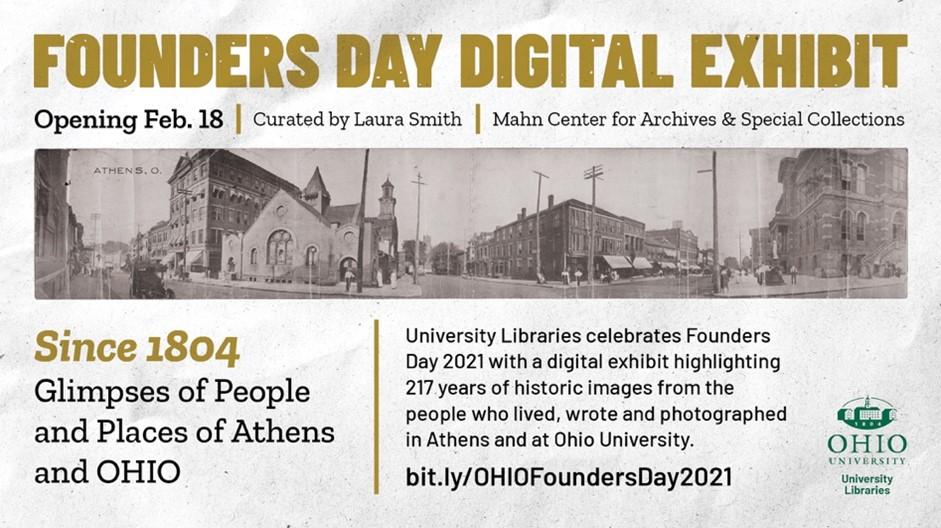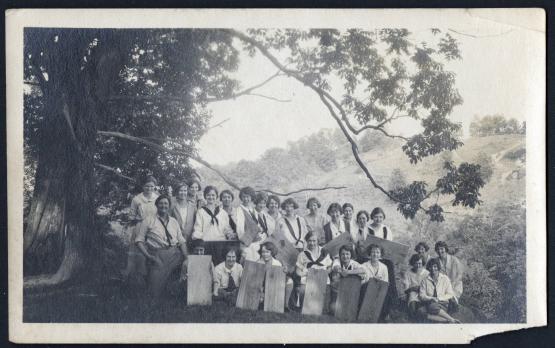

Ohio University Libraries will present its annual Founders Day exhibit digitally this year to celebrate 217 years since Ohio University was established on Feb. 18, 1804. The exhibit, titled “ Since 1804: Glimpses of People and Places of Athens & OHIO ,” will explore the history of the town and University through the letters, journals, photographs and much more created by those who have lived and learned in Athens.
The University observes Founders Day every year, remembering when OHIO was the only institute of higher education in the old Northwest Territory, and celebrating its status as the oldest university in the state of Ohio.
Laura Smith , photo archivist for University Libraries, curated the digital exhibit with assistance from Miriam Intrator , special collections librarian, and Intrator’s graduate assistant, Abbie Dykstra. Smith dug into many of the Libraries’ collections to find materials for the Founders exhibit, including many of the digital collections available on the Libraries’ website.

" I think the idea for this exhibit came out of everybody social distancing and not experiencing Athens and OHIO in the ways that they had before,” Smith said. “We wanted to create some sense of community and…draw out the stories of the many people who have experienced campus and town in their own ways.”
The “Since 1804” exhibit is made up of six individual story maps focusing on particular time periods and themes. The resources and images on the digital display were chosen to illustrate the story of that period. The post-World War II section, for example, displays a poster issued by the University directing students where to go when the Victory in Europe Proclamation was declared, and a letter written by an enrolled veteran waiting for married housing so his wife could join him in Athens, among other interesting resources. The exhibit includes maps that users can click on to further explore Athens during different time periods.
According to Smith, the new digital format of this year’s Founders Day exhibit presented some additional challenges, but also offered benefits, such as the ability to create interactive components and the opportunity to share the exhibit with a potentially wider audience.
“With the digital exhibit, I was able to do a bit more interactivity than I would have with the in-person exhibit,” she said, “and I was able to re-imagine the exhibit in different ways. It was easier to draw out different aspects of the exhibit and sort of guide people through it.”
Smith made sure to include the history of both the University and the town, drawing from resources like newspapers and scrapbooks to tell the stories of individuals and groups of people.
Smith hopes that those who see the exhibit realize the breadth and depth of resources in the Libraries’ archives, which are freely available to everyone. Even as we are in the midst of a global pandemic, she said, many materials are available to explore online in the Digital Archives .
“There’s so much to explore in the archives and so much to explore in history,” she said. “Whether you’re…interested in history of people or places, there’s so much information and original primary resource materials available to use.”
One section of the digital exhibit even includes a place where users can learn more about adding their own experiences and memories to OHIO’s collections. In the “ Share Your Story ” section, OHIO community members can record their memories on an interactive map of Athens in “Mapping Memories: OHIO Bobcats Share Their Stories.” Students are also invited to share their experiences with Covid-19 in “Students Preserving History.”
Both “ Mapping Memories ” and “ Students Preserving History ” were developed by the Libraries last year as a way to record this unique moment in history and to provide new ways for the community to engage with archives and special collections.
“I hope that there’s something here for everybody,” she said, “and that there’s something for anybody who’s interested in archival materials…and wants to learn a little bit about the history of Athens and Ohio University.”
